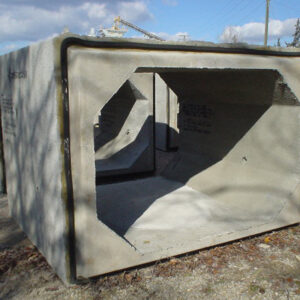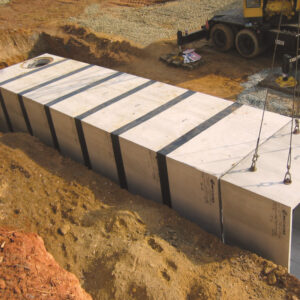The alternative to precast concrete pipe is the building block of underground infrastructure called the box culvert. They are essentially the Lego of modern precast structures and simply snap together for easy installation.
As with any product that utilizes a joint that could move, you inherently run the risk of infiltration or exfiltration. Therefore you need to mitigate that risk by sealing it.
But with what?
First let’s understand the design of precast box culverts.
Precast Box Culvert Design
Precast box culverts come in several sizes. They can be anywhere from 3-feet wide and 2-feet tall all the way up to 12-foot by 12-foot. And typically come in 6-foot and 8-foot lengths.
Other features include:
- Joint design
- Three-sided instead of four-sided
- Linings & coatings
Codes will also inherently affect the design of a box culvert, especially when non-standard sizing is required. This is permissible and must be designed per project design specification.
What are Box Culvert’s Used for?
Because of their design and scale, precast box culverts can be used for a variety of applications other than just conveying water. Some of these might include:
- Pedestrian tunnels – the boxes can be placed under roads or bridges to allow safe passage of pedestrians or bicyclists
- Stormwater conveyance – allows for natural waterways to move under roads and bridges
- Utility systems – useful as ducts for electrical, cables, water, oil or even steam
What to Use to Seal the Joint?
The exceptional strength of precast box culverts provides a wide variety of uses, but no design is perfect – especially when considering how differential settlement can cause fluctuations in the connection.
So how do you prevent these potential gaps from leaking water in or out at the joint?
We offer four options for sealing the joints – profile gaskets, butyl rubber sealant, butyl exterior wrap or cellular joint filler.
Butyl Exterior Joint Wrap
Butyl joint wrap is really just a big piece of tape that is used as a secondary seal on box culverts, manholes or even concrete pipe. One big difference is the rubber or plastic backing we offer in 12” EZ Wrap.
This added security to the joint of your box culvert gives you peace of mind knowing that you’ve sealed the structure both inside and out to prevent leaks.
Want more security?
How about the fact that we are the only wrap manufacturer that utilizes a spray adhesive option to maximize even more bonding to the surface.
Long term sealing, added security to the joint and a choice between butyl rubber or plastic backing makes EZ-Wrap an ideal choice for box culvert jobs.
Profile Rubber Gaskets
Our type 4G wedge and RFS (Reduced Friction Seal) pre-lubricated gaskets are available for watertight applications meeting ASTM C 1677.
But with different joint designs, you’ll need to consider the proper gasket design.
A tongue and groove joint will be less compatible to a gasket than a butyl sealant would be. But this also means that your joint isn’t nearly as watertight and the resiliency of the sealant isn’t as high as a rubber gasket.
A single offset joint is much more applicable for rubber gaskets like our type 4G or RFS. The homing force between the joint and the gasket provides greater sealing forces.
Our wedge and pre-lubricated gaskets meet or exceed:
- ASTM C 1677
- ASTM C 443
- ASTM C 1619
- CSA A 257.3
Now back to the butyl sealant we mentioned for tongue and groove joints.
Butyl Rubber Sealant
The Pro-Stik or EZ-Stik sealant we offer are both butyl sealants containing no bitumen or asphalt materials and meet ASTM C 990, Section 6.2.
As an all-weather sealant, box culvert manufacturers and the contractors who install them can have greater reassurance that the sealant will perform better in cold or hot weather climates unlike the mastic or blended materials.
To make it even easier to purchase from Press-Seal, we also offer a wide-variety of shapes and sizes to fit some of the most unique box culvert joints in the market today.
 Cellular Joint Filler
Cellular Joint Filler
For a quick and easy solution for filling box culvert joints, look to our cellular joint filler to get the job done faster. The varying sizes and shapes for soil and silt tight applications meeting ASTM D 1056 means you get the job done right and quicker the first time.

